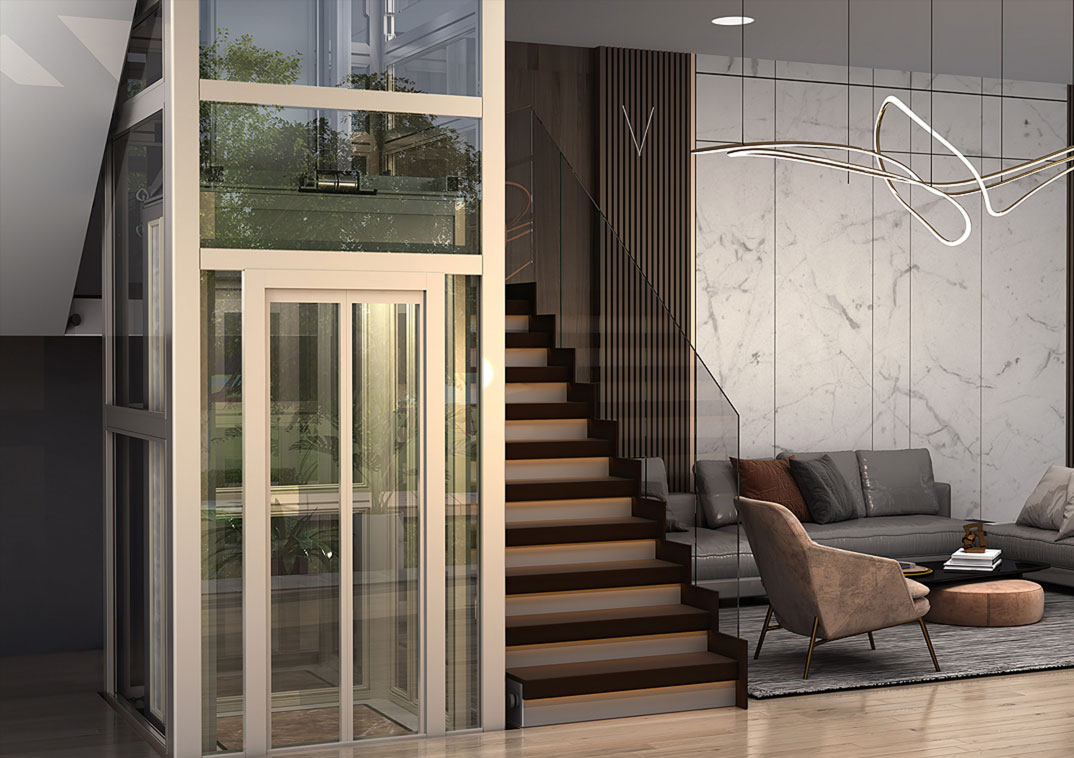As modern homes pursue more comfort and convenience, Villa Elevators have gradually become an important configuration for duplex, split-level and multi-story residences. However, while improving the quality of life, users are also paying more attention to the energy consumption performance and operation stability of elevators.
1. Energy-saving drive technology: optimization of the core power system
Traditional elevators are usually driven by traction motors, which have high energy consumption and obvious noise. Modern villa elevators generally use permanent magnet synchronous gearless traction machines or screw drive systems, which greatly reduce energy consumption.
Permanent magnet synchronous motors have the advantages of high efficiency, low heat generation, and fast response. They can automatically adjust the output power according to the load to avoid "idling" and waste of electricity;
Screw drive systems are suitable for small load scenarios, with compact structure, no need for machine rooms, and high energy conversion rate, which is particularly suitable for home environments.
In addition, some high-end villa elevators have also introduced energy feedback devices to convert the kinetic energy generated when the elevator goes down into electrical energy and feed it back to the power grid, further achieving energy-saving effects.
2. Intelligent control system: precise regulation to improve efficiency
The smooth operation of villa elevators is inseparable from advanced intelligent control systems. Modern products are generally equipped with variable frequency speed controllers (VFD), which can adjust the motor speed in real time according to the elevator operation status, making the start and stop softer and reducing vibration and noise.
At the same time, some brands are also equipped with AI artificial intelligence algorithms, which learn the user's usage habits, predict the demand for elevators in advance and optimize the order of stopping floors, thereby reducing unnecessary start and stop times, reducing energy consumption and improving the riding experience.
3. Lightweight materials and structural design: the key to reducing load and consumption
In order to adapt to the space limitations of the family, villa elevators often adopt a compact design, which also puts higher requirements on their structure. Lightweight and high-strength materials such as aluminum alloy frames, composite guide rails and carbon fiber belts are widely used in elevator cars and track systems, which not only reduce the overall weight, but also effectively reduce the running resistance.
In addition, some products adopt a machine room-free design, which saves the space occupied by the traditional elevator top machine room, while reducing additional heat dissipation and lighting energy consumption, further improving the overall energy efficiency.

4. Intelligent energy-saving function: the truth is in the details
Modern villa elevators are also equipped with a variety of intelligent energy-saving functions, such as:
Automatic sleep mode: When no one is using it for a long time, the elevator automatically enters a low-power standby state;
LED energy-saving lighting: The car uses a low-power LED light source with high brightness and long life;
Infrared sensor wake-up: When someone is detected approaching, the elevator automatically resumes operation, taking into account energy saving and convenience.
These details can continue to play a role in daily use and significantly reduce long-term operating costs.
5. Performance in actual application scenarios
In actual applications, the low energy consumption and stable operation characteristics of villa elevators are particularly favored by home users:
For the elderly or those with limited mobility, the stability of the elevator is directly related to the safety and comfort of use;
For users with a strong awareness of energy saving and environmental protection, the low-energy design can not only reduce electricity bills, but also conform to the concept of green home;
In high-end residential projects, the quiet, energy-saving and beautiful integrated design of villa elevators has also become a plus point.
The reason why villa elevators can achieve low energy consumption and smooth operation in limited spaces is inseparable from the upgrade of drive technology, optimization of intelligent control systems and innovation of material structure. In the future, with the deep integration of technologies such as the Internet of Things and artificial intelligence, villa elevators will continue to evolve in terms of energy saving, safety, and comfort, providing modern families with more efficient and environmentally friendly vertical travel solutions.











